Impact of Mammography Screening on Carcinoma in situ Breast Cancer
VerifiedAdded on 2021/06/17
|17
|4348
|78
Report
AI Summary
This report investigates the impact of mammography screening and overdiagnosis in women aged 50-70 diagnosed with carcinoma in situ breast cancer in England, utilizing a retrospective cohort study design. The research aims to identify the extent of overdiagnosis of in situ breast cancer through routine data from the NHS Breast Cancer Screening Programme and to assess the association between mammography screening and surgery outcomes. The study hypothesizes that mammography screening is linked to the overdiagnosis of carcinoma in situ breast cancer, comparing survival rates between women aged 60-70 with non-invasive breast cancer and those with neutral presentations. Data is sourced from the National Cancer Registration and Analysis Service (NCRAS) and Hospital Episodes Statistics (HES) to analyze cases registered between 2006 and 2016, focusing on non-invasive breast cancer (ICD-10 codes D05.0 – D05.9) detected via mammography screening and symptomatic cases. The inclusion and exclusion criteria are defined, and ethical issues are considered, ensuring a comprehensive analysis of mammography screening's impact on breast cancer diagnosis and treatment outcomes.
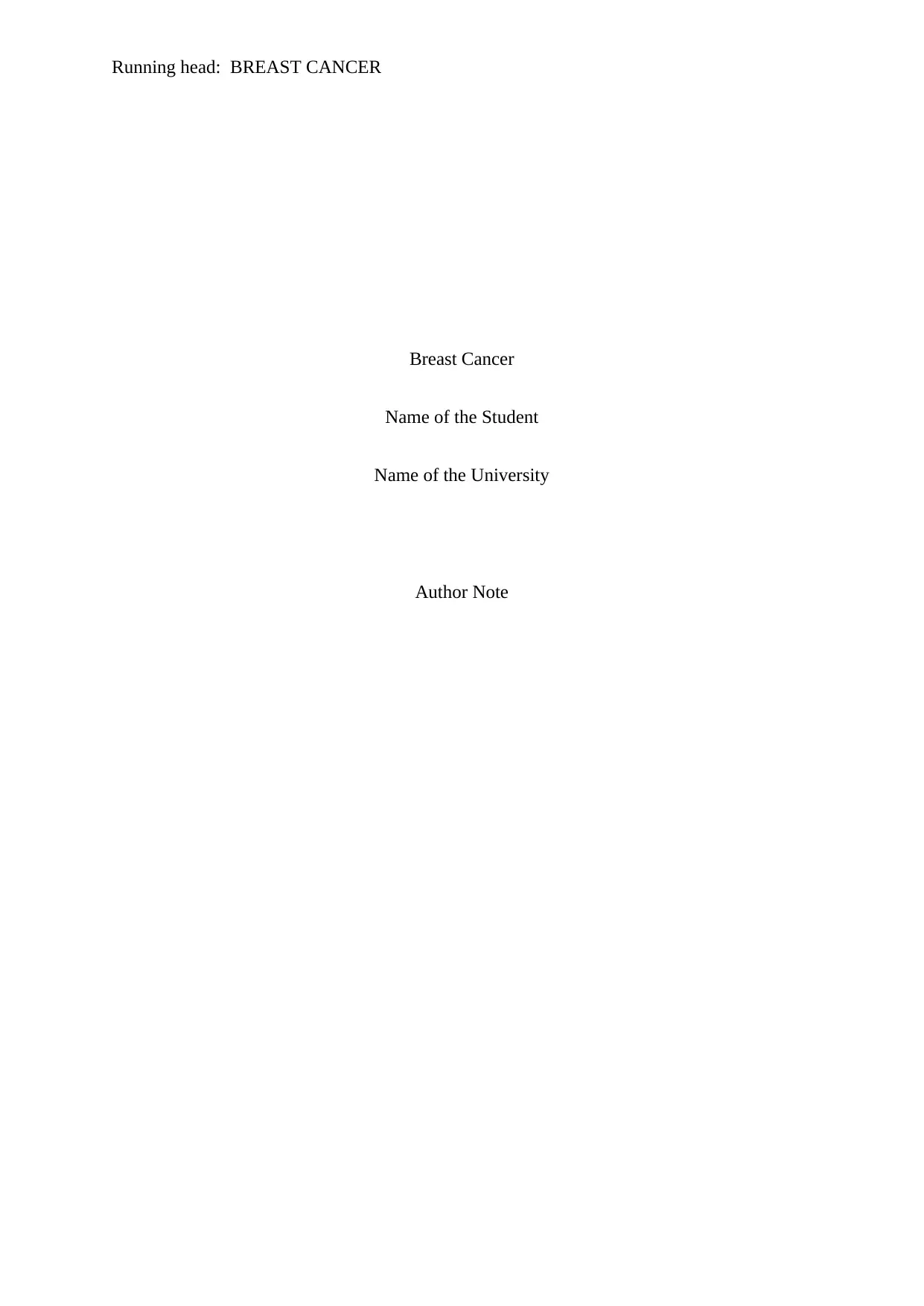
Running head: BREAST CANCER
Breast Cancer
Name of the Student
Name of the University
Author Note
Breast Cancer
Name of the Student
Name of the University
Author Note
Paraphrase This Document
Need a fresh take? Get an instant paraphrase of this document with our AI Paraphraser
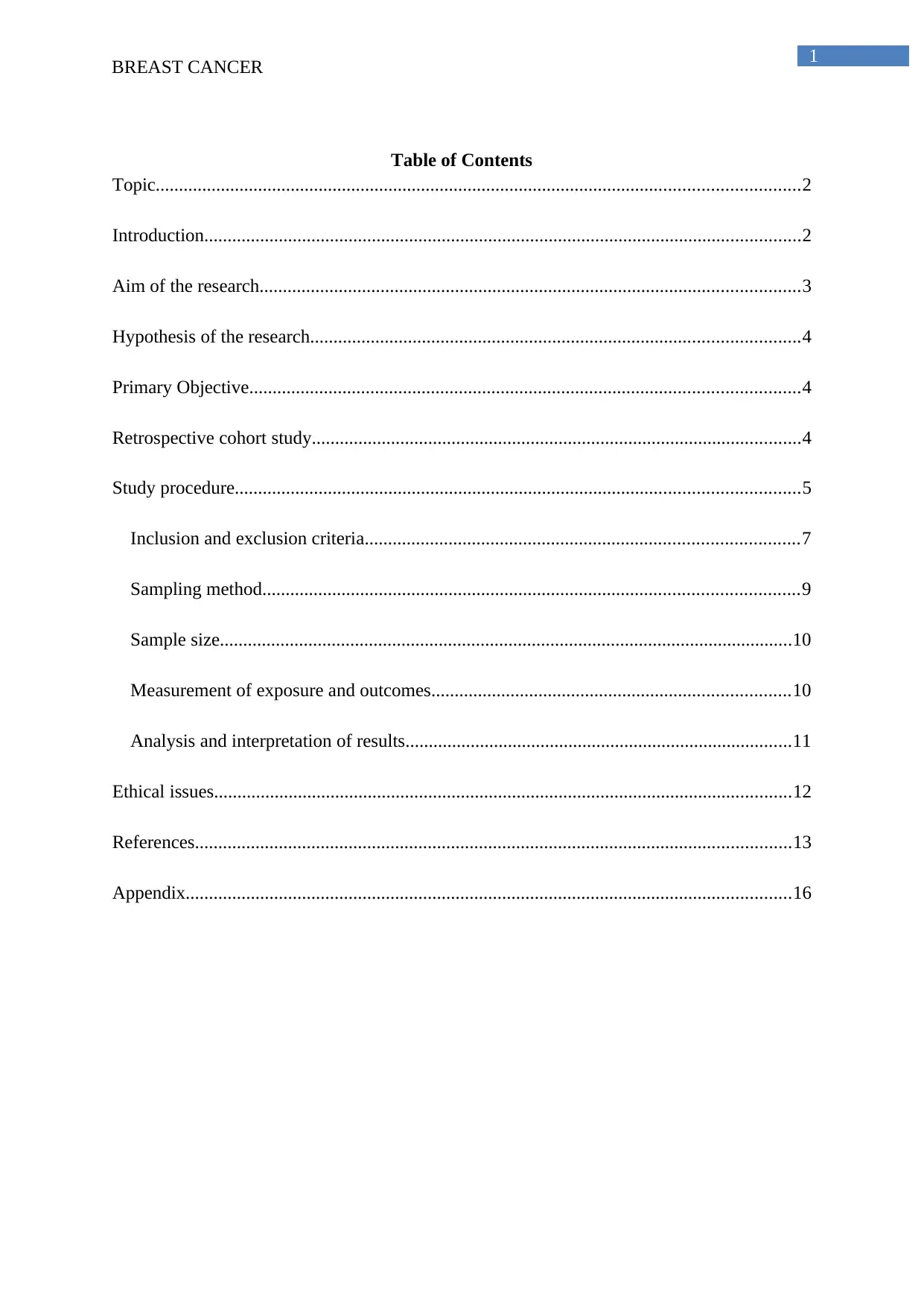
1
BREAST CANCER
Table of Contents
Topic..........................................................................................................................................2
Introduction................................................................................................................................2
Aim of the research....................................................................................................................3
Hypothesis of the research.........................................................................................................4
Primary Objective......................................................................................................................4
Retrospective cohort study.........................................................................................................4
Study procedure.........................................................................................................................5
Inclusion and exclusion criteria.............................................................................................7
Sampling method...................................................................................................................9
Sample size...........................................................................................................................10
Measurement of exposure and outcomes.............................................................................10
Analysis and interpretation of results...................................................................................11
Ethical issues............................................................................................................................12
References................................................................................................................................13
Appendix..................................................................................................................................16
BREAST CANCER
Table of Contents
Topic..........................................................................................................................................2
Introduction................................................................................................................................2
Aim of the research....................................................................................................................3
Hypothesis of the research.........................................................................................................4
Primary Objective......................................................................................................................4
Retrospective cohort study.........................................................................................................4
Study procedure.........................................................................................................................5
Inclusion and exclusion criteria.............................................................................................7
Sampling method...................................................................................................................9
Sample size...........................................................................................................................10
Measurement of exposure and outcomes.............................................................................10
Analysis and interpretation of results...................................................................................11
Ethical issues............................................................................................................................12
References................................................................................................................................13
Appendix..................................................................................................................................16

2
BREAST CANCER
Topic
The impact of mammography screening and overdiagnosis in women aged 50-70 diagnosed
with Carcinoma in situ breast cancer and surgery outcome: a retrospective cohort study in
England.
Introduction
According to the data published in the official website of Breast Cancer.org (2017),
breast cancer is defined as malignant tumour that has originated from the cell residing in the
mammary gland. The most common form of breast cancer in the European population is
upper-outer quadrant of breast cancer and is mainly common in white females in comparison
to the Asian or the black females residing in UK [1]. The main cause of breast cancer is
genetic. At least 5 to 10% of the breast cancer cases are inherited, and 85 to 90% of breast
cancer arises from genetic abnormality, common during the process of ageing [2]. Thus it
can be said that the likelihood of breast cancer increases with age [4].
Non-invasive form of breast cancer stays within the lobules or milk duct and they do
not invade other normal tissues of the body beyond breast. Invasive form of breast cancer
migrates into other healthy tissues of the body leading in the abnormal proliferation of the
malignant celli lines and exponential spread of the disease. At times both invasive and non-
invasive are seen in one single samples an at times breast cancer also results from mixed
tumour that contains a mixture of both the cancerous ductal cells and lobular cells [3].
As per the reports published by the Cancer Research UK (2017), annually there are
nearly 54,900 reported cases of breast cancer in UK. It is the most common form of cancer in
women in UK amounting nearly 15% of all new cases of cancer in 2015. While the rate of
BREAST CANCER
Topic
The impact of mammography screening and overdiagnosis in women aged 50-70 diagnosed
with Carcinoma in situ breast cancer and surgery outcome: a retrospective cohort study in
England.
Introduction
According to the data published in the official website of Breast Cancer.org (2017),
breast cancer is defined as malignant tumour that has originated from the cell residing in the
mammary gland. The most common form of breast cancer in the European population is
upper-outer quadrant of breast cancer and is mainly common in white females in comparison
to the Asian or the black females residing in UK [1]. The main cause of breast cancer is
genetic. At least 5 to 10% of the breast cancer cases are inherited, and 85 to 90% of breast
cancer arises from genetic abnormality, common during the process of ageing [2]. Thus it
can be said that the likelihood of breast cancer increases with age [4].
Non-invasive form of breast cancer stays within the lobules or milk duct and they do
not invade other normal tissues of the body beyond breast. Invasive form of breast cancer
migrates into other healthy tissues of the body leading in the abnormal proliferation of the
malignant celli lines and exponential spread of the disease. At times both invasive and non-
invasive are seen in one single samples an at times breast cancer also results from mixed
tumour that contains a mixture of both the cancerous ductal cells and lobular cells [3].
As per the reports published by the Cancer Research UK (2017), annually there are
nearly 54,900 reported cases of breast cancer in UK. It is the most common form of cancer in
women in UK amounting nearly 15% of all new cases of cancer in 2015. While the rate of
⊘ This is a preview!⊘
Do you want full access?
Subscribe today to unlock all pages.

Trusted by 1+ million students worldwide
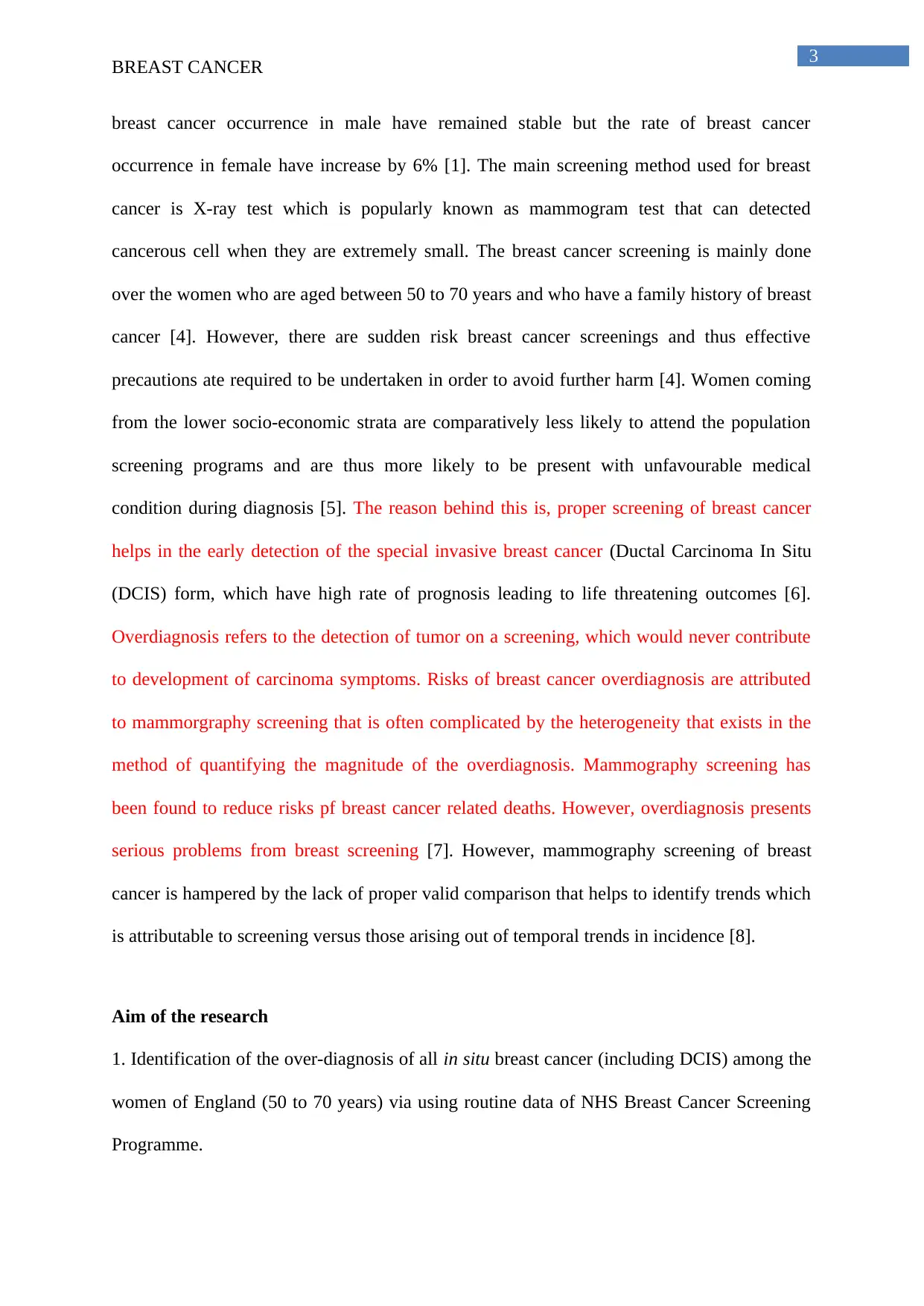
3
BREAST CANCER
breast cancer occurrence in male have remained stable but the rate of breast cancer
occurrence in female have increase by 6% [1]. The main screening method used for breast
cancer is X-ray test which is popularly known as mammogram test that can detected
cancerous cell when they are extremely small. The breast cancer screening is mainly done
over the women who are aged between 50 to 70 years and who have a family history of breast
cancer [4]. However, there are sudden risk breast cancer screenings and thus effective
precautions ate required to be undertaken in order to avoid further harm [4]. Women coming
from the lower socio-economic strata are comparatively less likely to attend the population
screening programs and are thus more likely to be present with unfavourable medical
condition during diagnosis [5]. The reason behind this is, proper screening of breast cancer
helps in the early detection of the special invasive breast cancer (Ductal Carcinoma In Situ
(DCIS) form, which have high rate of prognosis leading to life threatening outcomes [6].
Overdiagnosis refers to the detection of tumor on a screening, which would never contribute
to development of carcinoma symptoms. Risks of breast cancer overdiagnosis are attributed
to mammorgraphy screening that is often complicated by the heterogeneity that exists in the
method of quantifying the magnitude of the overdiagnosis. Mammography screening has
been found to reduce risks pf breast cancer related deaths. However, overdiagnosis presents
serious problems from breast screening [7]. However, mammography screening of breast
cancer is hampered by the lack of proper valid comparison that helps to identify trends which
is attributable to screening versus those arising out of temporal trends in incidence [8].
Aim of the research
1. Identification of the over-diagnosis of all in situ breast cancer (including DCIS) among the
women of England (50 to 70 years) via using routine data of NHS Breast Cancer Screening
Programme.
BREAST CANCER
breast cancer occurrence in male have remained stable but the rate of breast cancer
occurrence in female have increase by 6% [1]. The main screening method used for breast
cancer is X-ray test which is popularly known as mammogram test that can detected
cancerous cell when they are extremely small. The breast cancer screening is mainly done
over the women who are aged between 50 to 70 years and who have a family history of breast
cancer [4]. However, there are sudden risk breast cancer screenings and thus effective
precautions ate required to be undertaken in order to avoid further harm [4]. Women coming
from the lower socio-economic strata are comparatively less likely to attend the population
screening programs and are thus more likely to be present with unfavourable medical
condition during diagnosis [5]. The reason behind this is, proper screening of breast cancer
helps in the early detection of the special invasive breast cancer (Ductal Carcinoma In Situ
(DCIS) form, which have high rate of prognosis leading to life threatening outcomes [6].
Overdiagnosis refers to the detection of tumor on a screening, which would never contribute
to development of carcinoma symptoms. Risks of breast cancer overdiagnosis are attributed
to mammorgraphy screening that is often complicated by the heterogeneity that exists in the
method of quantifying the magnitude of the overdiagnosis. Mammography screening has
been found to reduce risks pf breast cancer related deaths. However, overdiagnosis presents
serious problems from breast screening [7]. However, mammography screening of breast
cancer is hampered by the lack of proper valid comparison that helps to identify trends which
is attributable to screening versus those arising out of temporal trends in incidence [8].
Aim of the research
1. Identification of the over-diagnosis of all in situ breast cancer (including DCIS) among the
women of England (50 to 70 years) via using routine data of NHS Breast Cancer Screening
Programme.
Paraphrase This Document
Need a fresh take? Get an instant paraphrase of this document with our AI Paraphraser
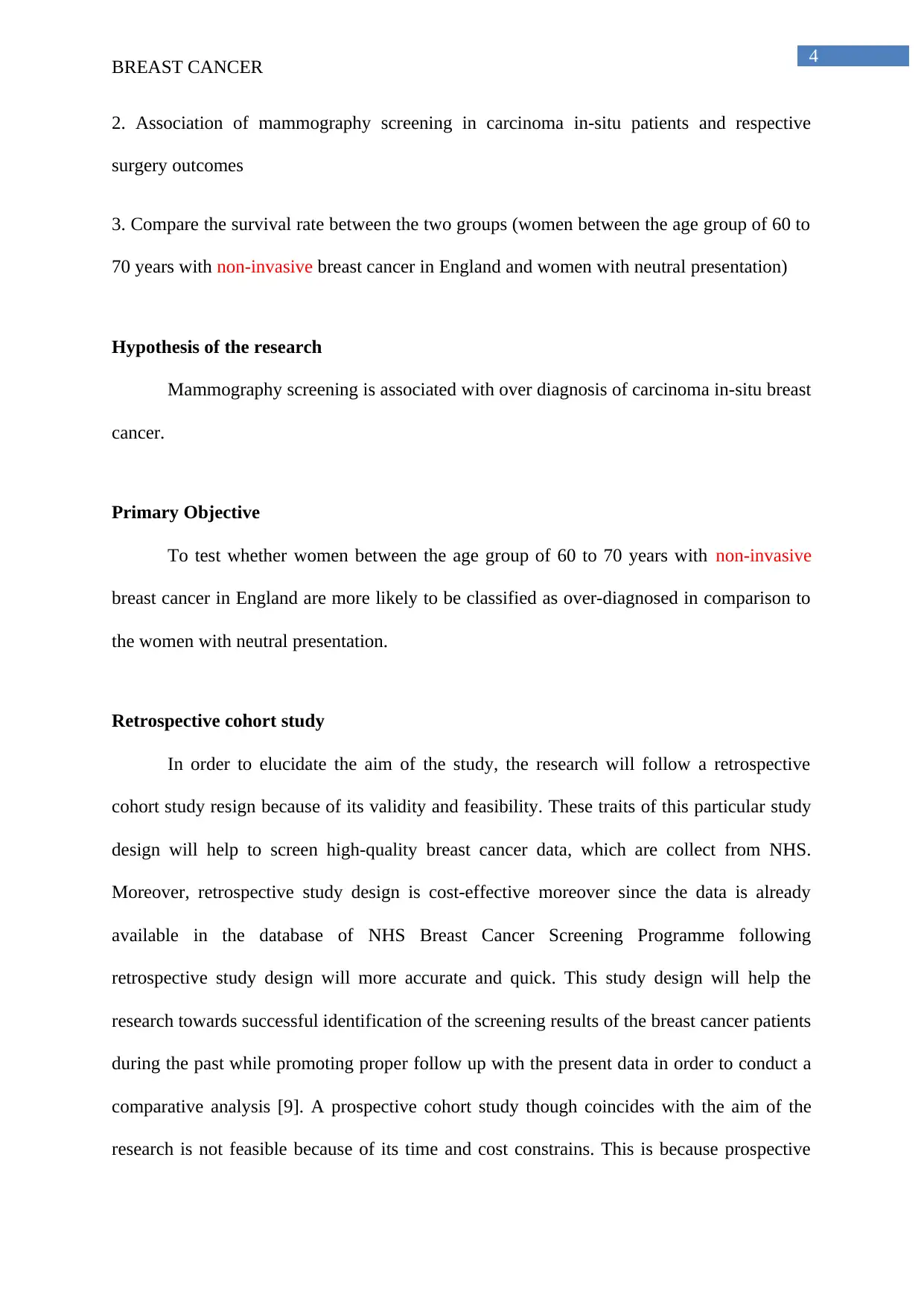
4
BREAST CANCER
2. Association of mammography screening in carcinoma in-situ patients and respective
surgery outcomes
3. Compare the survival rate between the two groups (women between the age group of 60 to
70 years with non-invasive breast cancer in England and women with neutral presentation)
Hypothesis of the research
Mammography screening is associated with over diagnosis of carcinoma in-situ breast
cancer.
Primary Objective
To test whether women between the age group of 60 to 70 years with non-invasive
breast cancer in England are more likely to be classified as over-diagnosed in comparison to
the women with neutral presentation.
Retrospective cohort study
In order to elucidate the aim of the study, the research will follow a retrospective
cohort study resign because of its validity and feasibility. These traits of this particular study
design will help to screen high-quality breast cancer data, which are collect from NHS.
Moreover, retrospective study design is cost-effective moreover since the data is already
available in the database of NHS Breast Cancer Screening Programme following
retrospective study design will more accurate and quick. This study design will help the
research towards successful identification of the screening results of the breast cancer patients
during the past while promoting proper follow up with the present data in order to conduct a
comparative analysis [9]. A prospective cohort study though coincides with the aim of the
research is not feasible because of its time and cost constrains. This is because prospective
BREAST CANCER
2. Association of mammography screening in carcinoma in-situ patients and respective
surgery outcomes
3. Compare the survival rate between the two groups (women between the age group of 60 to
70 years with non-invasive breast cancer in England and women with neutral presentation)
Hypothesis of the research
Mammography screening is associated with over diagnosis of carcinoma in-situ breast
cancer.
Primary Objective
To test whether women between the age group of 60 to 70 years with non-invasive
breast cancer in England are more likely to be classified as over-diagnosed in comparison to
the women with neutral presentation.
Retrospective cohort study
In order to elucidate the aim of the study, the research will follow a retrospective
cohort study resign because of its validity and feasibility. These traits of this particular study
design will help to screen high-quality breast cancer data, which are collect from NHS.
Moreover, retrospective study design is cost-effective moreover since the data is already
available in the database of NHS Breast Cancer Screening Programme following
retrospective study design will more accurate and quick. This study design will help the
research towards successful identification of the screening results of the breast cancer patients
during the past while promoting proper follow up with the present data in order to conduct a
comparative analysis [9]. A prospective cohort study though coincides with the aim of the
research is not feasible because of its time and cost constrains. This is because prospective
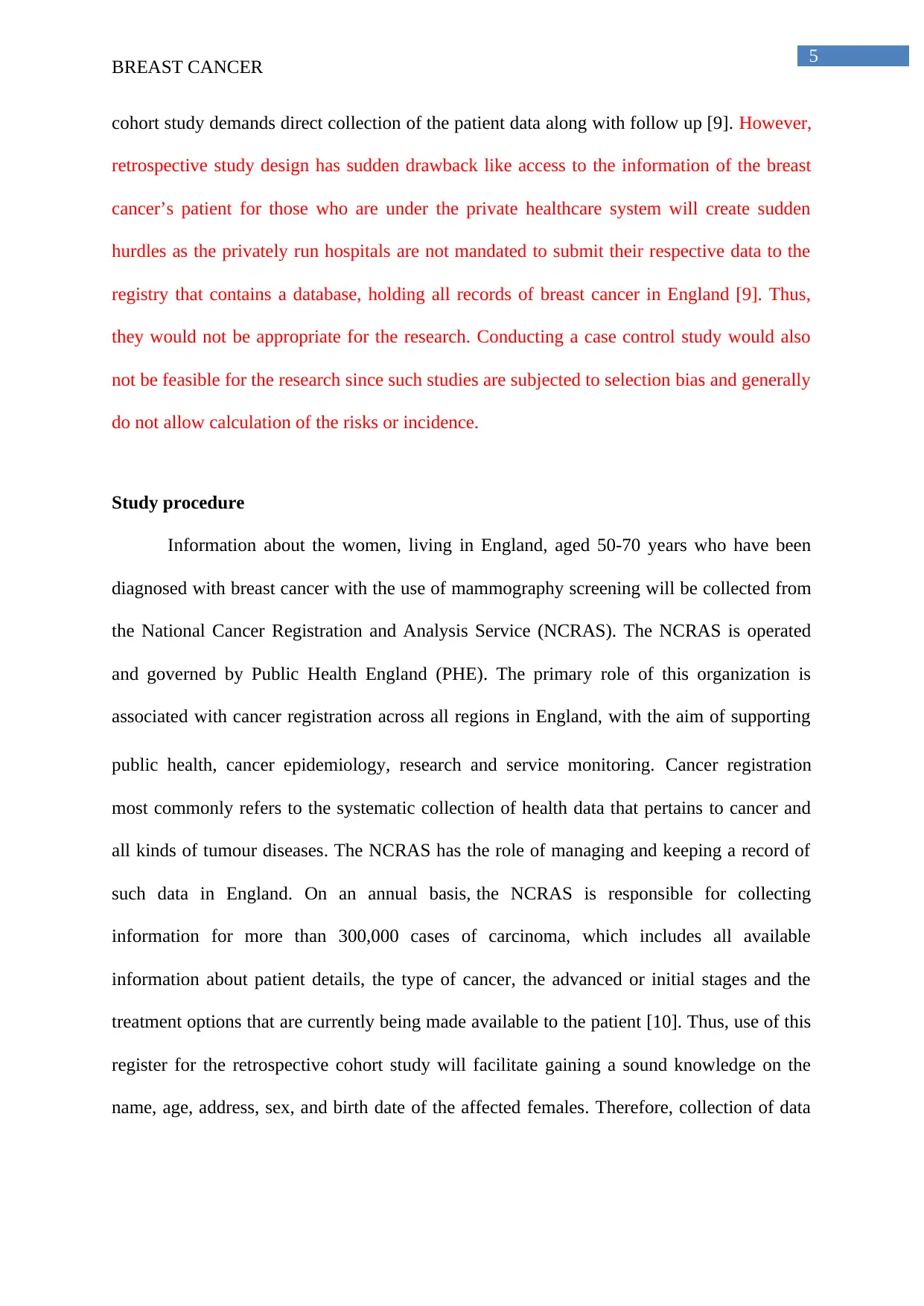
5
BREAST CANCER
cohort study demands direct collection of the patient data along with follow up [9]. However,
retrospective study design has sudden drawback like access to the information of the breast
cancer’s patient for those who are under the private healthcare system will create sudden
hurdles as the privately run hospitals are not mandated to submit their respective data to the
registry that contains a database, holding all records of breast cancer in England [9]. Thus,
they would not be appropriate for the research. Conducting a case control study would also
not be feasible for the research since such studies are subjected to selection bias and generally
do not allow calculation of the risks or incidence.
Study procedure
Information about the women, living in England, aged 50-70 years who have been
diagnosed with breast cancer with the use of mammography screening will be collected from
the National Cancer Registration and Analysis Service (NCRAS). The NCRAS is operated
and governed by Public Health England (PHE). The primary role of this organization is
associated with cancer registration across all regions in England, with the aim of supporting
public health, cancer epidemiology, research and service monitoring. Cancer registration
most commonly refers to the systematic collection of health data that pertains to cancer and
all kinds of tumour diseases. The NCRAS has the role of managing and keeping a record of
such data in England. On an annual basis, the NCRAS is responsible for collecting
information for more than 300,000 cases of carcinoma, which includes all available
information about patient details, the type of cancer, the advanced or initial stages and the
treatment options that are currently being made available to the patient [10]. Thus, use of this
register for the retrospective cohort study will facilitate gaining a sound knowledge on the
name, age, address, sex, and birth date of the affected females. Therefore, collection of data
BREAST CANCER
cohort study demands direct collection of the patient data along with follow up [9]. However,
retrospective study design has sudden drawback like access to the information of the breast
cancer’s patient for those who are under the private healthcare system will create sudden
hurdles as the privately run hospitals are not mandated to submit their respective data to the
registry that contains a database, holding all records of breast cancer in England [9]. Thus,
they would not be appropriate for the research. Conducting a case control study would also
not be feasible for the research since such studies are subjected to selection bias and generally
do not allow calculation of the risks or incidence.
Study procedure
Information about the women, living in England, aged 50-70 years who have been
diagnosed with breast cancer with the use of mammography screening will be collected from
the National Cancer Registration and Analysis Service (NCRAS). The NCRAS is operated
and governed by Public Health England (PHE). The primary role of this organization is
associated with cancer registration across all regions in England, with the aim of supporting
public health, cancer epidemiology, research and service monitoring. Cancer registration
most commonly refers to the systematic collection of health data that pertains to cancer and
all kinds of tumour diseases. The NCRAS has the role of managing and keeping a record of
such data in England. On an annual basis, the NCRAS is responsible for collecting
information for more than 300,000 cases of carcinoma, which includes all available
information about patient details, the type of cancer, the advanced or initial stages and the
treatment options that are currently being made available to the patient [10]. Thus, use of this
register for the retrospective cohort study will facilitate gaining a sound knowledge on the
name, age, address, sex, and birth date of the affected females. Therefore, collection of data
⊘ This is a preview!⊘
Do you want full access?
Subscribe today to unlock all pages.

Trusted by 1+ million students worldwide
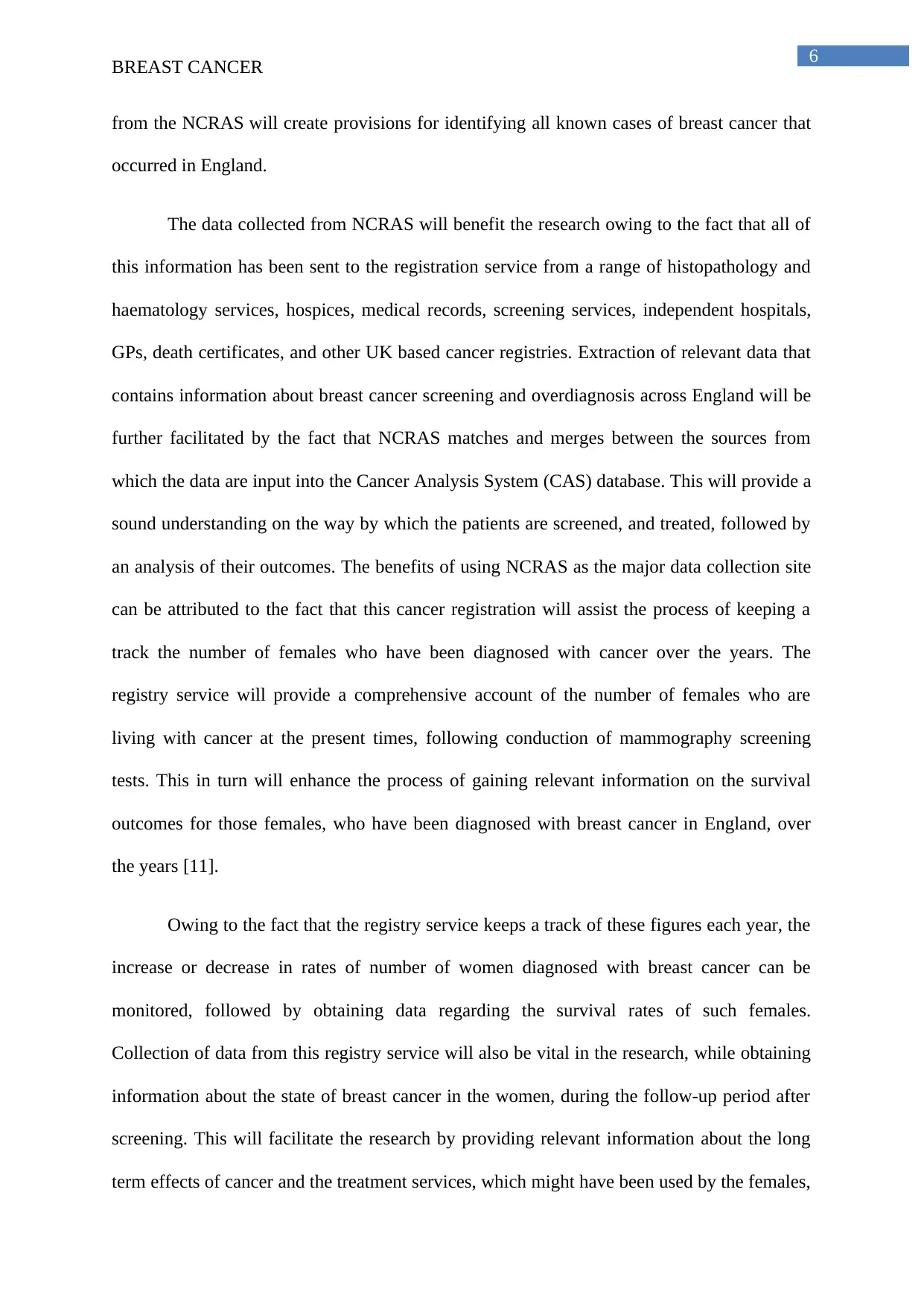
6
BREAST CANCER
from the NCRAS will create provisions for identifying all known cases of breast cancer that
occurred in England.
The data collected from NCRAS will benefit the research owing to the fact that all of
this information has been sent to the registration service from a range of histopathology and
haematology services, hospices, medical records, screening services, independent hospitals,
GPs, death certificates, and other UK based cancer registries. Extraction of relevant data that
contains information about breast cancer screening and overdiagnosis across England will be
further facilitated by the fact that NCRAS matches and merges between the sources from
which the data are input into the Cancer Analysis System (CAS) database. This will provide a
sound understanding on the way by which the patients are screened, and treated, followed by
an analysis of their outcomes. The benefits of using NCRAS as the major data collection site
can be attributed to the fact that this cancer registration will assist the process of keeping a
track the number of females who have been diagnosed with cancer over the years. The
registry service will provide a comprehensive account of the number of females who are
living with cancer at the present times, following conduction of mammography screening
tests. This in turn will enhance the process of gaining relevant information on the survival
outcomes for those females, who have been diagnosed with breast cancer in England, over
the years [11].
Owing to the fact that the registry service keeps a track of these figures each year, the
increase or decrease in rates of number of women diagnosed with breast cancer can be
monitored, followed by obtaining data regarding the survival rates of such females.
Collection of data from this registry service will also be vital in the research, while obtaining
information about the state of breast cancer in the women, during the follow-up period after
screening. This will facilitate the research by providing relevant information about the long
term effects of cancer and the treatment services, which might have been used by the females,
BREAST CANCER
from the NCRAS will create provisions for identifying all known cases of breast cancer that
occurred in England.
The data collected from NCRAS will benefit the research owing to the fact that all of
this information has been sent to the registration service from a range of histopathology and
haematology services, hospices, medical records, screening services, independent hospitals,
GPs, death certificates, and other UK based cancer registries. Extraction of relevant data that
contains information about breast cancer screening and overdiagnosis across England will be
further facilitated by the fact that NCRAS matches and merges between the sources from
which the data are input into the Cancer Analysis System (CAS) database. This will provide a
sound understanding on the way by which the patients are screened, and treated, followed by
an analysis of their outcomes. The benefits of using NCRAS as the major data collection site
can be attributed to the fact that this cancer registration will assist the process of keeping a
track the number of females who have been diagnosed with cancer over the years. The
registry service will provide a comprehensive account of the number of females who are
living with cancer at the present times, following conduction of mammography screening
tests. This in turn will enhance the process of gaining relevant information on the survival
outcomes for those females, who have been diagnosed with breast cancer in England, over
the years [11].
Owing to the fact that the registry service keeps a track of these figures each year, the
increase or decrease in rates of number of women diagnosed with breast cancer can be
monitored, followed by obtaining data regarding the survival rates of such females.
Collection of data from this registry service will also be vital in the research, while obtaining
information about the state of breast cancer in the women, during the follow-up period after
screening. This will facilitate the research by providing relevant information about the long
term effects of cancer and the treatment services, which might have been used by the females,
Paraphrase This Document
Need a fresh take? Get an instant paraphrase of this document with our AI Paraphraser

7
BREAST CANCER
after being diagnosed. Thus, the primary data gathered from NCRAS will enable gaining a
deeper understanding of the risks of breast cancer overdiagnosis that can be attributed to
mammography screening. Furthermore, the cancer clinicians are found to regularly assess
quality of health outcomes for all patients, receiving specific carcinoma treatments, with the
aim of ensuring delivery of equal healthcare services to the patients being diagnosed with the
disease [12]. This clinical audit will act as an integral method for the research proposal by
providing the assurance that the details of the women, diagnosed with breast cancer after
mammography are being routinely investigated, thereby adding validity to the data.
Data collection procedure will also utilise the National NHS Breast Screening
Programme. This service of the Public Health England (PHE) protects and improves the
health and wellbeing of the nation, by reducing health inequalities. The primary role of the
UK National Screening Committee (UK NSC) pertains to developing a set of screening
policies [13]. The research was guided by the fact that the UK NSC recommends all eligible
women, aged 50-70 years to get screened for breast cancer, every three years. This screening
helps in detecting breast cancers at the earliest, maximising treatment success and reducing
mortality rates. Hence, data collected from the NHS Breast Screening Programme are
imperative for the research. Moreover, data from Hospital Episodes Statistics (HES) will also
facilitate the research owing to the fact that it acts as a data warehouse that will provide
exhaustive information on all patients who had been admitted to NHS hospitals, across
England, for treatment of breast cancer, after conduction of screening tests [14]. Thus, the
statistics will add reliability to the data collected for the research.
Inclusion and exclusion criteria
Inclusion criteria refer to characteristics that the prospective subjects must manifest or
have, in order to get included in the research [15]. The inclusion criteria for participants
recruited for this research are given below:
BREAST CANCER
after being diagnosed. Thus, the primary data gathered from NCRAS will enable gaining a
deeper understanding of the risks of breast cancer overdiagnosis that can be attributed to
mammography screening. Furthermore, the cancer clinicians are found to regularly assess
quality of health outcomes for all patients, receiving specific carcinoma treatments, with the
aim of ensuring delivery of equal healthcare services to the patients being diagnosed with the
disease [12]. This clinical audit will act as an integral method for the research proposal by
providing the assurance that the details of the women, diagnosed with breast cancer after
mammography are being routinely investigated, thereby adding validity to the data.
Data collection procedure will also utilise the National NHS Breast Screening
Programme. This service of the Public Health England (PHE) protects and improves the
health and wellbeing of the nation, by reducing health inequalities. The primary role of the
UK National Screening Committee (UK NSC) pertains to developing a set of screening
policies [13]. The research was guided by the fact that the UK NSC recommends all eligible
women, aged 50-70 years to get screened for breast cancer, every three years. This screening
helps in detecting breast cancers at the earliest, maximising treatment success and reducing
mortality rates. Hence, data collected from the NHS Breast Screening Programme are
imperative for the research. Moreover, data from Hospital Episodes Statistics (HES) will also
facilitate the research owing to the fact that it acts as a data warehouse that will provide
exhaustive information on all patients who had been admitted to NHS hospitals, across
England, for treatment of breast cancer, after conduction of screening tests [14]. Thus, the
statistics will add reliability to the data collected for the research.
Inclusion and exclusion criteria
Inclusion criteria refer to characteristics that the prospective subjects must manifest or
have, in order to get included in the research [15]. The inclusion criteria for participants
recruited for this research are given below:
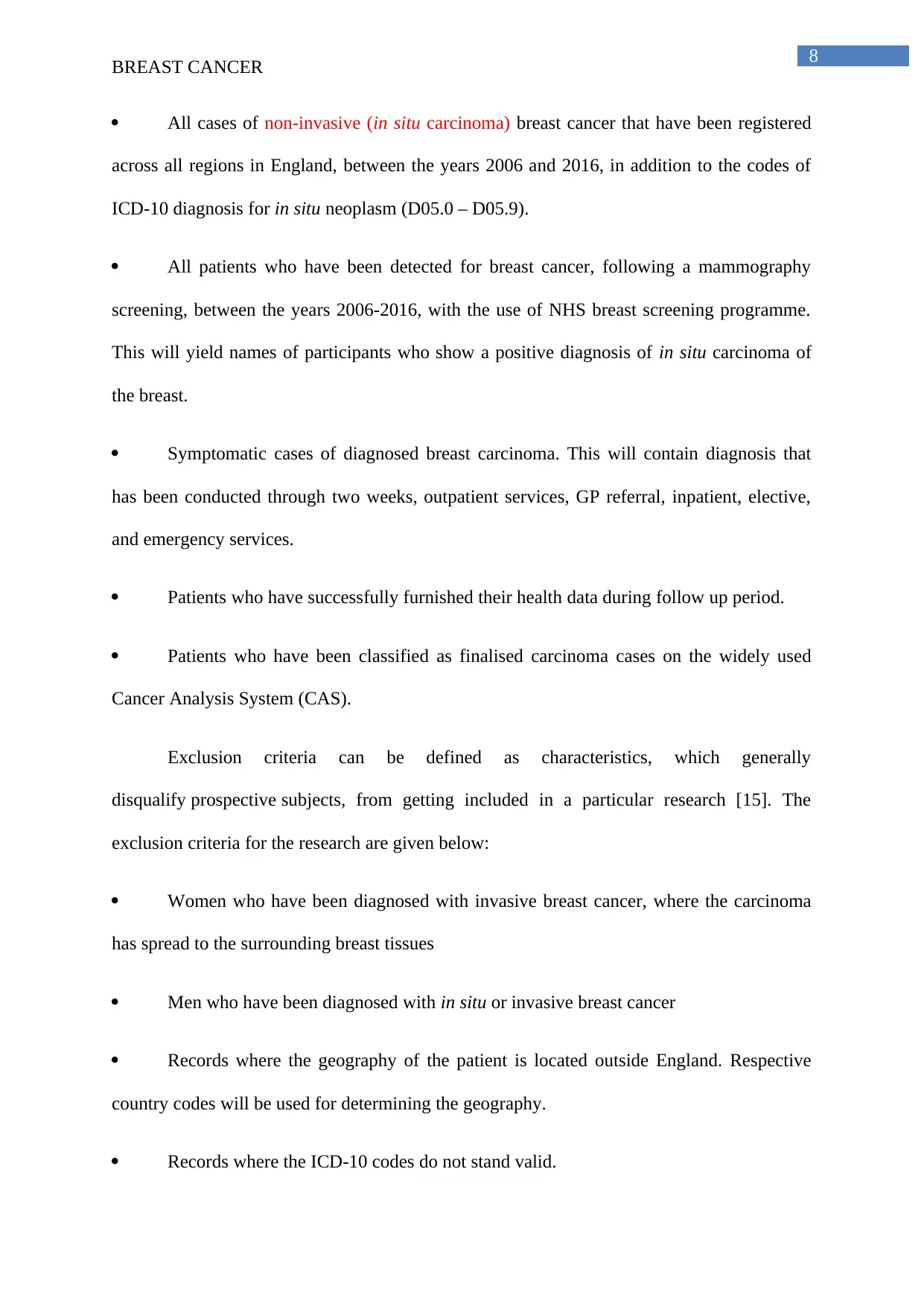
8
BREAST CANCER
All cases of non-invasive (in situ carcinoma) breast cancer that have been registered
across all regions in England, between the years 2006 and 2016, in addition to the codes of
ICD-10 diagnosis for in situ neoplasm (D05.0 – D05.9).
All patients who have been detected for breast cancer, following a mammography
screening, between the years 2006-2016, with the use of NHS breast screening programme.
This will yield names of participants who show a positive diagnosis of in situ carcinoma of
the breast.
Symptomatic cases of diagnosed breast carcinoma. This will contain diagnosis that
has been conducted through two weeks, outpatient services, GP referral, inpatient, elective,
and emergency services.
Patients who have successfully furnished their health data during follow up period.
Patients who have been classified as finalised carcinoma cases on the widely used
Cancer Analysis System (CAS).
Exclusion criteria can be defined as characteristics, which generally
disqualify prospective subjects, from getting included in a particular research [15]. The
exclusion criteria for the research are given below:
Women who have been diagnosed with invasive breast cancer, where the carcinoma
has spread to the surrounding breast tissues
Men who have been diagnosed with in situ or invasive breast cancer
Records where the geography of the patient is located outside England. Respective
country codes will be used for determining the geography.
Records where the ICD-10 codes do not stand valid.
BREAST CANCER
All cases of non-invasive (in situ carcinoma) breast cancer that have been registered
across all regions in England, between the years 2006 and 2016, in addition to the codes of
ICD-10 diagnosis for in situ neoplasm (D05.0 – D05.9).
All patients who have been detected for breast cancer, following a mammography
screening, between the years 2006-2016, with the use of NHS breast screening programme.
This will yield names of participants who show a positive diagnosis of in situ carcinoma of
the breast.
Symptomatic cases of diagnosed breast carcinoma. This will contain diagnosis that
has been conducted through two weeks, outpatient services, GP referral, inpatient, elective,
and emergency services.
Patients who have successfully furnished their health data during follow up period.
Patients who have been classified as finalised carcinoma cases on the widely used
Cancer Analysis System (CAS).
Exclusion criteria can be defined as characteristics, which generally
disqualify prospective subjects, from getting included in a particular research [15]. The
exclusion criteria for the research are given below:
Women who have been diagnosed with invasive breast cancer, where the carcinoma
has spread to the surrounding breast tissues
Men who have been diagnosed with in situ or invasive breast cancer
Records where the geography of the patient is located outside England. Respective
country codes will be used for determining the geography.
Records where the ICD-10 codes do not stand valid.
⊘ This is a preview!⊘
Do you want full access?
Subscribe today to unlock all pages.

Trusted by 1+ million students worldwide
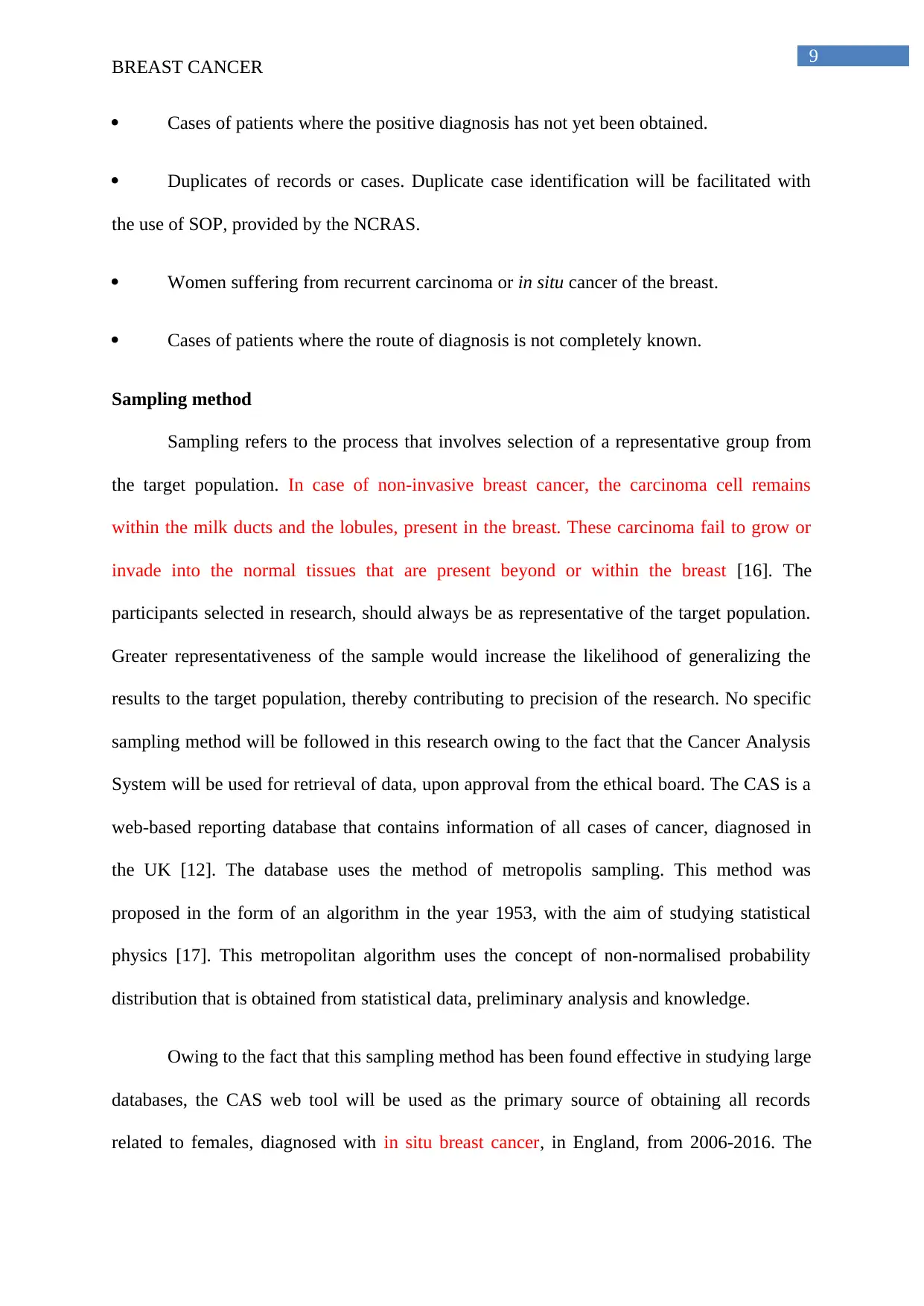
9
BREAST CANCER
Cases of patients where the positive diagnosis has not yet been obtained.
Duplicates of records or cases. Duplicate case identification will be facilitated with
the use of SOP, provided by the NCRAS.
Women suffering from recurrent carcinoma or in situ cancer of the breast.
Cases of patients where the route of diagnosis is not completely known.
Sampling method
Sampling refers to the process that involves selection of a representative group from
the target population. In case of non-invasive breast cancer, the carcinoma cell remains
within the milk ducts and the lobules, present in the breast. These carcinoma fail to grow or
invade into the normal tissues that are present beyond or within the breast [16]. The
participants selected in research, should always be as representative of the target population.
Greater representativeness of the sample would increase the likelihood of generalizing the
results to the target population, thereby contributing to precision of the research. No specific
sampling method will be followed in this research owing to the fact that the Cancer Analysis
System will be used for retrieval of data, upon approval from the ethical board. The CAS is a
web-based reporting database that contains information of all cases of cancer, diagnosed in
the UK [12]. The database uses the method of metropolis sampling. This method was
proposed in the form of an algorithm in the year 1953, with the aim of studying statistical
physics [17]. This metropolitan algorithm uses the concept of non-normalised probability
distribution that is obtained from statistical data, preliminary analysis and knowledge.
Owing to the fact that this sampling method has been found effective in studying large
databases, the CAS web tool will be used as the primary source of obtaining all records
related to females, diagnosed with in situ breast cancer, in England, from 2006-2016. The
BREAST CANCER
Cases of patients where the positive diagnosis has not yet been obtained.
Duplicates of records or cases. Duplicate case identification will be facilitated with
the use of SOP, provided by the NCRAS.
Women suffering from recurrent carcinoma or in situ cancer of the breast.
Cases of patients where the route of diagnosis is not completely known.
Sampling method
Sampling refers to the process that involves selection of a representative group from
the target population. In case of non-invasive breast cancer, the carcinoma cell remains
within the milk ducts and the lobules, present in the breast. These carcinoma fail to grow or
invade into the normal tissues that are present beyond or within the breast [16]. The
participants selected in research, should always be as representative of the target population.
Greater representativeness of the sample would increase the likelihood of generalizing the
results to the target population, thereby contributing to precision of the research. No specific
sampling method will be followed in this research owing to the fact that the Cancer Analysis
System will be used for retrieval of data, upon approval from the ethical board. The CAS is a
web-based reporting database that contains information of all cases of cancer, diagnosed in
the UK [12]. The database uses the method of metropolis sampling. This method was
proposed in the form of an algorithm in the year 1953, with the aim of studying statistical
physics [17]. This metropolitan algorithm uses the concept of non-normalised probability
distribution that is obtained from statistical data, preliminary analysis and knowledge.
Owing to the fact that this sampling method has been found effective in studying large
databases, the CAS web tool will be used as the primary source of obtaining all records
related to females, diagnosed with in situ breast cancer, in England, from 2006-2016. The
Paraphrase This Document
Need a fresh take? Get an instant paraphrase of this document with our AI Paraphraser
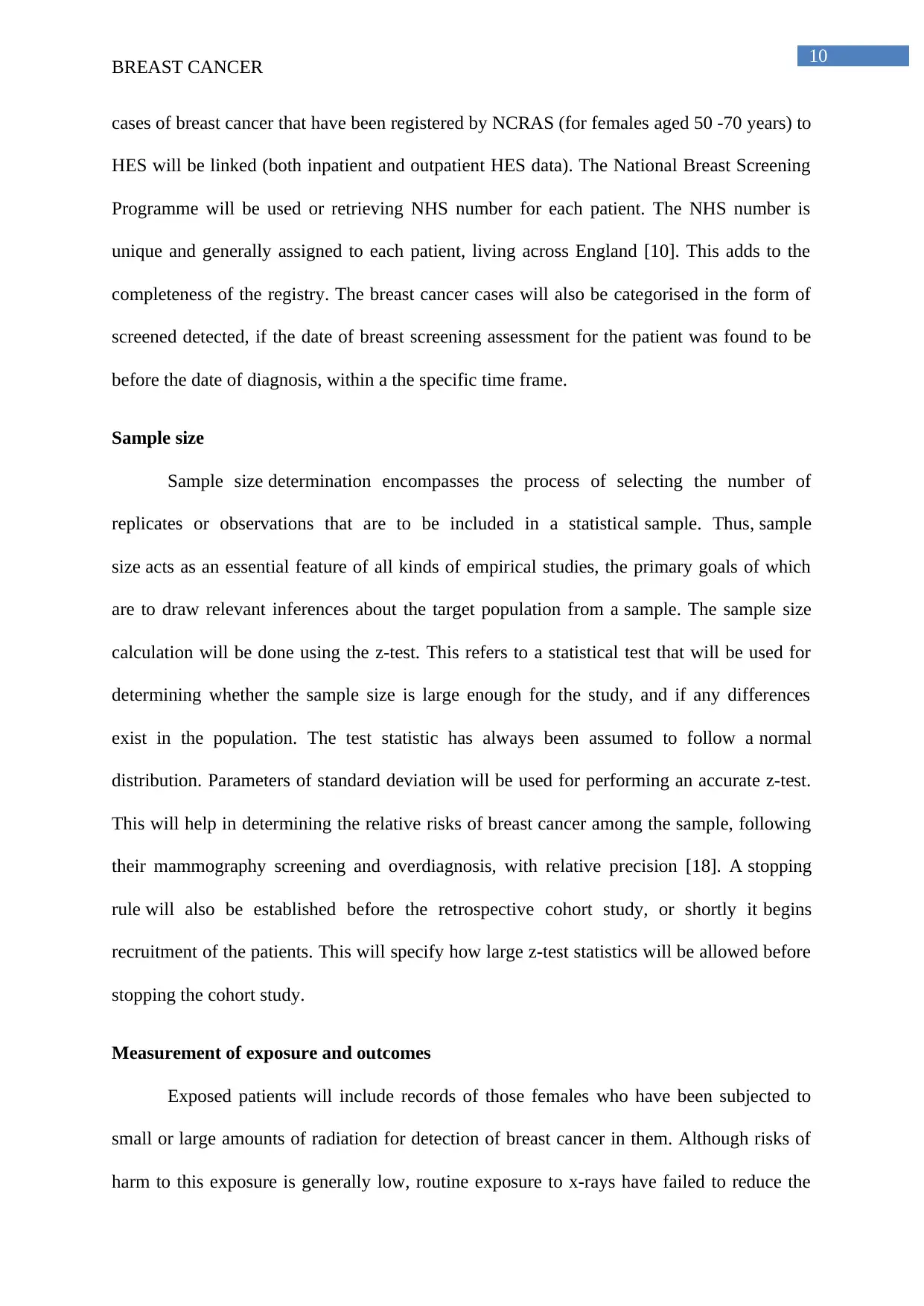
10
BREAST CANCER
cases of breast cancer that have been registered by NCRAS (for females aged 50 -70 years) to
HES will be linked (both inpatient and outpatient HES data). The National Breast Screening
Programme will be used or retrieving NHS number for each patient. The NHS number is
unique and generally assigned to each patient, living across England [10]. This adds to the
completeness of the registry. The breast cancer cases will also be categorised in the form of
screened detected, if the date of breast screening assessment for the patient was found to be
before the date of diagnosis, within a the specific time frame.
Sample size
Sample size determination encompasses the process of selecting the number of
replicates or observations that are to be included in a statistical sample. Thus, sample
size acts as an essential feature of all kinds of empirical studies, the primary goals of which
are to draw relevant inferences about the target population from a sample. The sample size
calculation will be done using the z-test. This refers to a statistical test that will be used for
determining whether the sample size is large enough for the study, and if any differences
exist in the population. The test statistic has always been assumed to follow a normal
distribution. Parameters of standard deviation will be used for performing an accurate z-test.
This will help in determining the relative risks of breast cancer among the sample, following
their mammography screening and overdiagnosis, with relative precision [18]. A stopping
rule will also be established before the retrospective cohort study, or shortly it begins
recruitment of the patients. This will specify how large z-test statistics will be allowed before
stopping the cohort study.
Measurement of exposure and outcomes
Exposed patients will include records of those females who have been subjected to
small or large amounts of radiation for detection of breast cancer in them. Although risks of
harm to this exposure is generally low, routine exposure to x-rays have failed to reduce the
BREAST CANCER
cases of breast cancer that have been registered by NCRAS (for females aged 50 -70 years) to
HES will be linked (both inpatient and outpatient HES data). The National Breast Screening
Programme will be used or retrieving NHS number for each patient. The NHS number is
unique and generally assigned to each patient, living across England [10]. This adds to the
completeness of the registry. The breast cancer cases will also be categorised in the form of
screened detected, if the date of breast screening assessment for the patient was found to be
before the date of diagnosis, within a the specific time frame.
Sample size
Sample size determination encompasses the process of selecting the number of
replicates or observations that are to be included in a statistical sample. Thus, sample
size acts as an essential feature of all kinds of empirical studies, the primary goals of which
are to draw relevant inferences about the target population from a sample. The sample size
calculation will be done using the z-test. This refers to a statistical test that will be used for
determining whether the sample size is large enough for the study, and if any differences
exist in the population. The test statistic has always been assumed to follow a normal
distribution. Parameters of standard deviation will be used for performing an accurate z-test.
This will help in determining the relative risks of breast cancer among the sample, following
their mammography screening and overdiagnosis, with relative precision [18]. A stopping
rule will also be established before the retrospective cohort study, or shortly it begins
recruitment of the patients. This will specify how large z-test statistics will be allowed before
stopping the cohort study.
Measurement of exposure and outcomes
Exposed patients will include records of those females who have been subjected to
small or large amounts of radiation for detection of breast cancer in them. Although risks of
harm to this exposure is generally low, routine exposure to x-rays have failed to reduce the
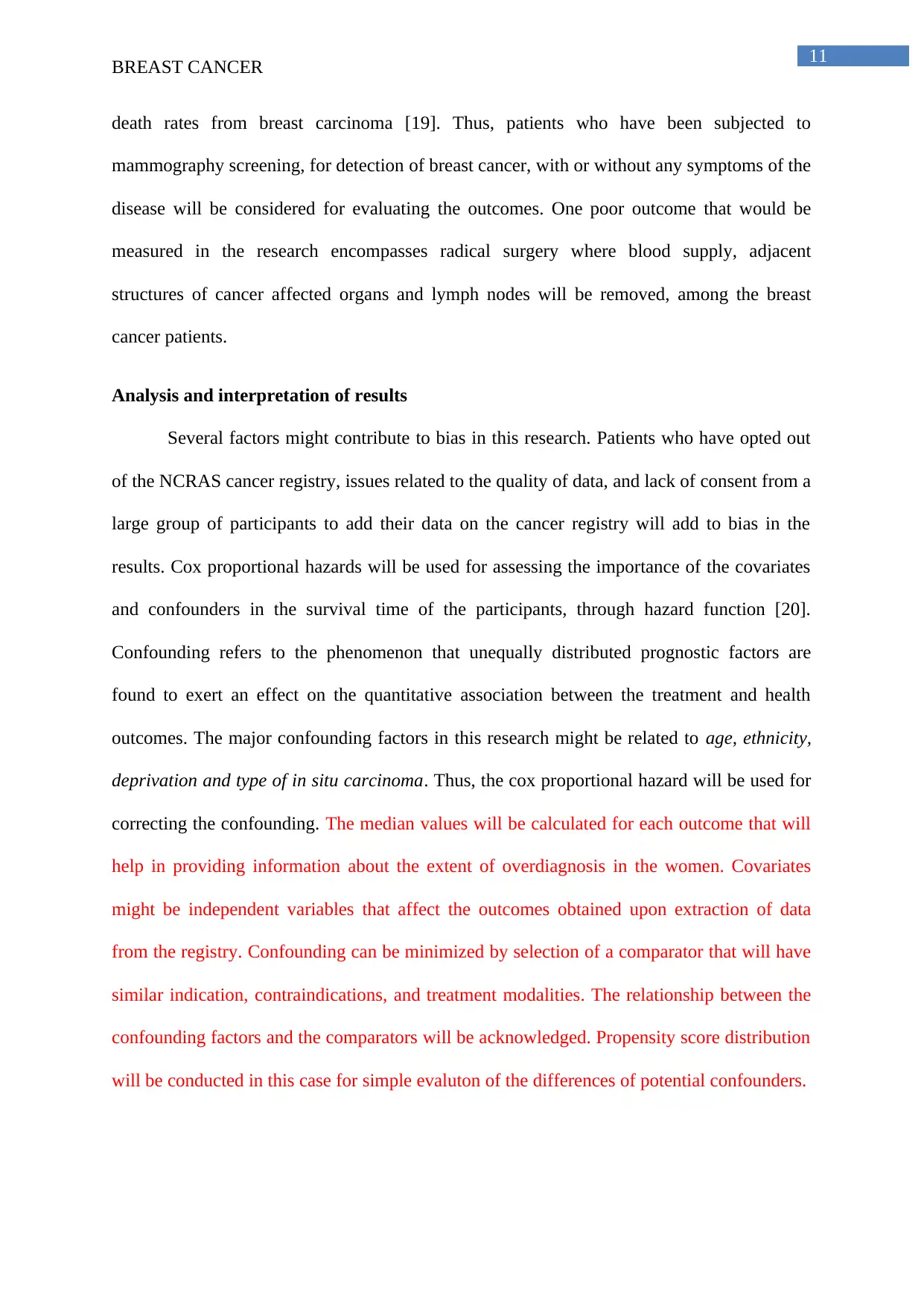
11
BREAST CANCER
death rates from breast carcinoma [19]. Thus, patients who have been subjected to
mammography screening, for detection of breast cancer, with or without any symptoms of the
disease will be considered for evaluating the outcomes. One poor outcome that would be
measured in the research encompasses radical surgery where blood supply, adjacent
structures of cancer affected organs and lymph nodes will be removed, among the breast
cancer patients.
Analysis and interpretation of results
Several factors might contribute to bias in this research. Patients who have opted out
of the NCRAS cancer registry, issues related to the quality of data, and lack of consent from a
large group of participants to add their data on the cancer registry will add to bias in the
results. Cox proportional hazards will be used for assessing the importance of the covariates
and confounders in the survival time of the participants, through hazard function [20].
Confounding refers to the phenomenon that unequally distributed prognostic factors are
found to exert an effect on the quantitative association between the treatment and health
outcomes. The major confounding factors in this research might be related to age, ethnicity,
deprivation and type of in situ carcinoma. Thus, the cox proportional hazard will be used for
correcting the confounding. The median values will be calculated for each outcome that will
help in providing information about the extent of overdiagnosis in the women. Covariates
might be independent variables that affect the outcomes obtained upon extraction of data
from the registry. Confounding can be minimized by selection of a comparator that will have
similar indication, contraindications, and treatment modalities. The relationship between the
confounding factors and the comparators will be acknowledged. Propensity score distribution
will be conducted in this case for simple evaluton of the differences of potential confounders.
BREAST CANCER
death rates from breast carcinoma [19]. Thus, patients who have been subjected to
mammography screening, for detection of breast cancer, with or without any symptoms of the
disease will be considered for evaluating the outcomes. One poor outcome that would be
measured in the research encompasses radical surgery where blood supply, adjacent
structures of cancer affected organs and lymph nodes will be removed, among the breast
cancer patients.
Analysis and interpretation of results
Several factors might contribute to bias in this research. Patients who have opted out
of the NCRAS cancer registry, issues related to the quality of data, and lack of consent from a
large group of participants to add their data on the cancer registry will add to bias in the
results. Cox proportional hazards will be used for assessing the importance of the covariates
and confounders in the survival time of the participants, through hazard function [20].
Confounding refers to the phenomenon that unequally distributed prognostic factors are
found to exert an effect on the quantitative association between the treatment and health
outcomes. The major confounding factors in this research might be related to age, ethnicity,
deprivation and type of in situ carcinoma. Thus, the cox proportional hazard will be used for
correcting the confounding. The median values will be calculated for each outcome that will
help in providing information about the extent of overdiagnosis in the women. Covariates
might be independent variables that affect the outcomes obtained upon extraction of data
from the registry. Confounding can be minimized by selection of a comparator that will have
similar indication, contraindications, and treatment modalities. The relationship between the
confounding factors and the comparators will be acknowledged. Propensity score distribution
will be conducted in this case for simple evaluton of the differences of potential confounders.
⊘ This is a preview!⊘
Do you want full access?
Subscribe today to unlock all pages.

Trusted by 1+ million students worldwide
1 out of 17
Related Documents
Your All-in-One AI-Powered Toolkit for Academic Success.
+13062052269
info@desklib.com
Available 24*7 on WhatsApp / Email
![[object Object]](/_next/static/media/star-bottom.7253800d.svg)
Unlock your academic potential
Copyright © 2020–2025 A2Z Services. All Rights Reserved. Developed and managed by ZUCOL.




